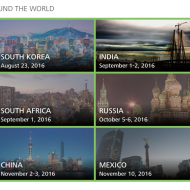Yesterday’s inspiring Innovation Forum “Everyone is a Designer” really brought home (literally for them, in some cases) the ability to:
- Dramatically increase the speed with which new products can be brought to market.
- Use the power of the Web to collaborate with creative minds around the world.
- Access today’s design software for the masses.
- Bring manufacturing out of the factory into the home office.
Eric Wilhelm, kite surfer and founder of Instructables.com started Instructables as a way to erase the barriers to inventing by helping people share what they’ve made with others. The site now hosts 85,000 projects.
David Lang, treasure hunter and co-founder, OpenROV, described his organization as “DIY ocean explorers.” Using Kickstarter, OpenROV was able to raise over $100,000 dollars to build their first generation of underwater robots. David’s main point is that from his perspective, the Maker movement and “democratization of design” is not do-it-yourself, but rather, a community collaboration. His personal quest to reskill himself turned into a great adventure. Now people all over the world are helping him reach his goal of creating an inexpensive, effective underwater robot for ocean exploring. Today’s technologies (3D printers, laser cutters, etc.) are easy to learn to use. Everyone can participate in the process of designing today, and “we’re all exploring this together.” His advice: Go out and find your own treasure.
Making his second appearance at AU this year (his first was at the Keynote Address), Schuyler St. Leger, enthusiastic amateur maker, talked about his own evolution using 3D printers and electronics as an example of the ability of youth to learn and push boundaries on technology. His own projects take advantage of inexpensive tools like Arduino boards and MakerBot™ 3D printers to be creative and inventive. Where did he learn all this? He said “Not from public school.” Shuyler’s own creative spark has been supported by his parents and others in the Maker community.
Jason Chua and Rachel Star of SparkTruck, an educational build-mobile from the Stanford d.School felt that the increasing standards requirements in public education were making it harder for kids to be creative. At a Maker Faire, they met Schuyler and he inspired them to start thinking of ways to take some of these technologies and transplant them into the classroom. Starting in the Bay area, they outfitted a truck and over 4 months traveled all over the U.S. with their program. Teachers and students said it was some of the most fun they’d had in years. They teach brainstorming, prototyping, and storytelling. For many students, this is “their first experience in unfiltered thinking.” Jason and Rachel’s goal is to “spark more young designers around the country.”
Anne Filson and Gary Rorhbacher, partners at Filson and Rohrbacher and co-founders of AtFAB, set out to create a new model for how designers create. If you define design as “recognizing the agency in yourself to change the world and you act on it,” then you are a designer. Anne and Gary want to live in a world where everyone is a designer by this definition. To promote this new way of thinking, they started AtFAB to “provoke consumers to become makers.” On the AtFAB website, a half-dozen personal parametric interfaces (furniture objects), such as for material thickness, enable anyone to design their own furniture. These furniture objects can be cut by a CNC router, laser cutter, or water jet from any off-the-shelf sheet material. One of their goals is to create an alternative to the centralized factory, by shipping “info not stuff.”
One of the forums most dynamic speakers, Ben Kaufmann, founder and CEO of Quirky.com, noticed how in recent decades, “we’ve become an incremental culture” and “invention has been replaced by innovation.” Companies mostly offer products that are incrementally better or different, and the pace of new product introductions has slowed dramatically. But he knew it could be different. His goal was to “make invention accessible” to everyone. Instead of taking 3 years to bring out a simple product, Quirky.com launches 3 brand new products every week. Product ideas come from people around the world, and then Quirky.com uses a combination of technology and community experts to bring products to market quickly. All involved get paid every time one unit of a product sells. What’s your next invention?
A recording of this session will be available on AU Virtual on the AUTV tab.
–sandy



